Ju Huang
Part I: Tricks or Traps? A Deep Dive into RL for LLM Reasoning
Aug 11, 2025Abstract:Reinforcement learning for LLM reasoning has rapidly emerged as a prominent research area, marked by a significant surge in related studies on both algorithmic innovations and practical applications. Despite this progress, several critical challenges remain, including the absence of standardized guidelines for employing RL techniques and a fragmented understanding of their underlying mechanisms. Additionally, inconsistent experimental settings, variations in training data, and differences in model initialization have led to conflicting conclusions, obscuring the key characteristics of these techniques and creating confusion among practitioners when selecting appropriate techniques. This paper systematically reviews widely adopted RL techniques through rigorous reproductions and isolated evaluations within a unified open-source framework. We analyze the internal mechanisms, applicable scenarios, and core principles of each technique through fine-grained experiments, including datasets of varying difficulty, model sizes, and architectures. Based on these insights, we present clear guidelines for selecting RL techniques tailored to specific setups, and provide a reliable roadmap for practitioners navigating the RL for the LLM domain. Finally, we reveal that a minimalist combination of two techniques can unlock the learning capability of critic-free policies using vanilla PPO loss. The results demonstrate that our simple combination consistently improves performance, surpassing strategies like GRPO and DAPO.
RecGPT Technical Report
Jul 30, 2025



Abstract:Recommender systems are among the most impactful applications of artificial intelligence, serving as critical infrastructure connecting users, merchants, and platforms. However, most current industrial systems remain heavily reliant on historical co-occurrence patterns and log-fitting objectives, i.e., optimizing for past user interactions without explicitly modeling user intent. This log-fitting approach often leads to overfitting to narrow historical preferences, failing to capture users' evolving and latent interests. As a result, it reinforces filter bubbles and long-tail phenomena, ultimately harming user experience and threatening the sustainability of the whole recommendation ecosystem. To address these challenges, we rethink the overall design paradigm of recommender systems and propose RecGPT, a next-generation framework that places user intent at the center of the recommendation pipeline. By integrating large language models (LLMs) into key stages of user interest mining, item retrieval, and explanation generation, RecGPT transforms log-fitting recommendation into an intent-centric process. To effectively align general-purpose LLMs to the above domain-specific recommendation tasks at scale, RecGPT incorporates a multi-stage training paradigm, which integrates reasoning-enhanced pre-alignment and self-training evolution, guided by a Human-LLM cooperative judge system. Currently, RecGPT has been fully deployed on the Taobao App. Online experiments demonstrate that RecGPT achieves consistent performance gains across stakeholders: users benefit from increased content diversity and satisfaction, merchants and the platform gain greater exposure and conversions. These comprehensive improvement results across all stakeholders validates that LLM-driven, intent-centric design can foster a more sustainable and mutually beneficial recommendation ecosystem.
MOFSimBench: Evaluating Universal Machine Learning Interatomic Potentials In Metal--Organic Framework Molecular Modeling
Jul 16, 2025Abstract:Universal machine learning interatomic potentials (uMLIPs) have emerged as powerful tools for accelerating atomistic simulations, offering scalable and efficient modeling with accuracy close to quantum calculations. However, their reliability and effectiveness in practical, real-world applications remain an open question. Metal-organic frameworks (MOFs) and related nanoporous materials are highly porous crystals with critical relevance in carbon capture, energy storage, and catalysis applications. Modeling nanoporous materials presents distinct challenges for uMLIPs due to their diverse chemistry, structural complexity, including porosity and coordination bonds, and the absence from existing training datasets. Here, we introduce MOFSimBench, a benchmark to evaluate uMLIPs on key materials modeling tasks for nanoporous materials, including structural optimization, molecular dynamics (MD) stability, the prediction of bulk properties, such as bulk modulus and heat capacity, and guest-host interactions. Evaluating over 20 models from various architectures on a chemically and structurally diverse materials set, we find that top-performing uMLIPs consistently outperform classical force fields and fine-tuned machine learning potentials across all tasks, demonstrating their readiness for deployment in nanoporous materials modeling. Our analysis highlights that data quality, particularly the diversity of training sets and inclusion of out-of-equilibrium conformations, plays a more critical role than model architecture in determining performance across all evaluated uMLIPs. We release our modular and extendable benchmarking framework at https://github.com/AI4ChemS/mofsim-bench, providing an open resource to guide the adoption for nanoporous materials modeling and further development of uMLIPs.
Reinforcement Learning Optimization for Large-Scale Learning: An Efficient and User-Friendly Scaling Library
Jun 06, 2025Abstract:We introduce ROLL, an efficient, scalable, and user-friendly library designed for Reinforcement Learning Optimization for Large-scale Learning. ROLL caters to three primary user groups: tech pioneers aiming for cost-effective, fault-tolerant large-scale training, developers requiring flexible control over training workflows, and researchers seeking agile experimentation. ROLL is built upon several key modules to serve these user groups effectively. First, a single-controller architecture combined with an abstraction of the parallel worker simplifies the development of the training pipeline. Second, the parallel strategy and data transfer modules enable efficient and scalable training. Third, the rollout scheduler offers fine-grained management of each sample's lifecycle during the rollout stage. Fourth, the environment worker and reward worker support rapid and flexible experimentation with agentic RL algorithms and reward designs. Finally, AutoDeviceMapping allows users to assign resources to different models flexibly across various stages.
Mamba-FETrack: Frame-Event Tracking via State Space Model
Apr 28, 2024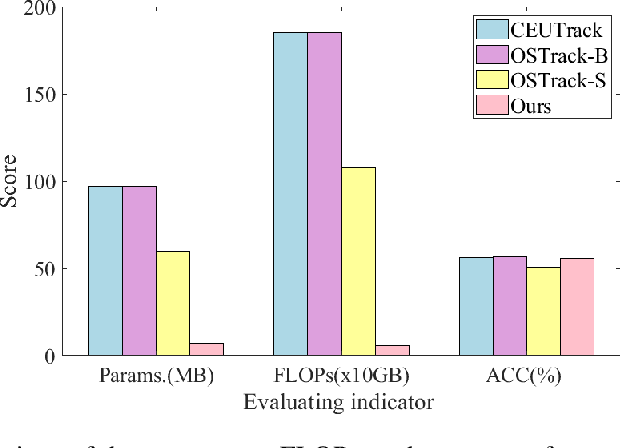


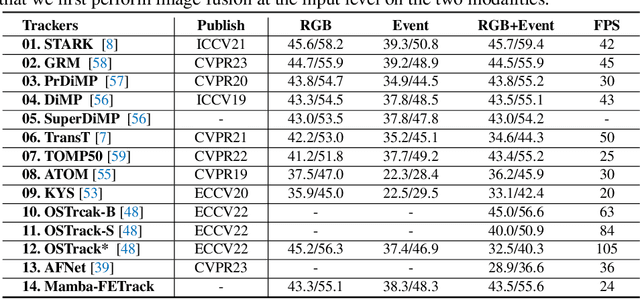
Abstract:RGB-Event based tracking is an emerging research topic, focusing on how to effectively integrate heterogeneous multi-modal data (synchronized exposure video frames and asynchronous pulse Event stream). Existing works typically employ Transformer based networks to handle these modalities and achieve decent accuracy through input-level or feature-level fusion on multiple datasets. However, these trackers require significant memory consumption and computational complexity due to the use of self-attention mechanism. This paper proposes a novel RGB-Event tracking framework, Mamba-FETrack, based on the State Space Model (SSM) to achieve high-performance tracking while effectively reducing computational costs and realizing more efficient tracking. Specifically, we adopt two modality-specific Mamba backbone networks to extract the features of RGB frames and Event streams. Then, we also propose to boost the interactive learning between the RGB and Event features using the Mamba network. The fused features will be fed into the tracking head for target object localization. Extensive experiments on FELT and FE108 datasets fully validated the efficiency and effectiveness of our proposed tracker. Specifically, our Mamba-based tracker achieves 43.5/55.6 on the SR/PR metric, while the ViT-S based tracker (OSTrack) obtains 40.0/50.9. The GPU memory cost of ours and ViT-S based tracker is 13.98GB and 15.44GB, which decreased about $9.5\%$. The FLOPs and parameters of ours/ViT-S based OSTrack are 59GB/1076GB and 7MB/60MB, which decreased about $94.5\%$ and $88.3\%$, respectively. We hope this work can bring some new insights to the tracking field and greatly promote the application of the Mamba architecture in tracking. The source code of this work will be released on \url{https://github.com/Event-AHU/Mamba_FETrack}.
State Space Model for New-Generation Network Alternative to Transformers: A Survey
Apr 15, 2024Abstract:In the post-deep learning era, the Transformer architecture has demonstrated its powerful performance across pre-trained big models and various downstream tasks. However, the enormous computational demands of this architecture have deterred many researchers. To further reduce the complexity of attention models, numerous efforts have been made to design more efficient methods. Among them, the State Space Model (SSM), as a possible replacement for the self-attention based Transformer model, has drawn more and more attention in recent years. In this paper, we give the first comprehensive review of these works and also provide experimental comparisons and analysis to better demonstrate the features and advantages of SSM. Specifically, we first give a detailed description of principles to help the readers quickly capture the key ideas of SSM. After that, we dive into the reviews of existing SSMs and their various applications, including natural language processing, computer vision, graph, multi-modal and multi-media, point cloud/event stream, time series data, and other domains. In addition, we give statistical comparisons and analysis of these models and hope it helps the readers to understand the effectiveness of different structures on various tasks. Then, we propose possible research points in this direction to better promote the development of the theoretical model and application of SSM. More related works will be continuously updated on the following GitHub: https://github.com/Event-AHU/Mamba_State_Space_Model_Paper_List.
Long-term Frame-Event Visual Tracking: Benchmark Dataset and Baseline
Mar 09, 2024

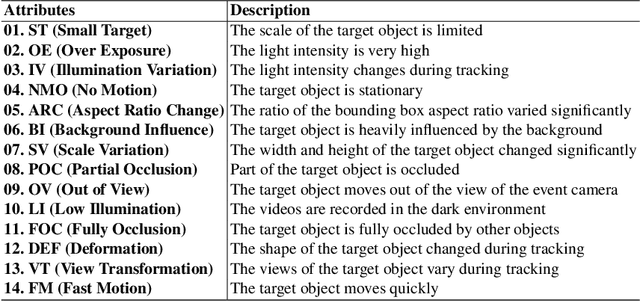
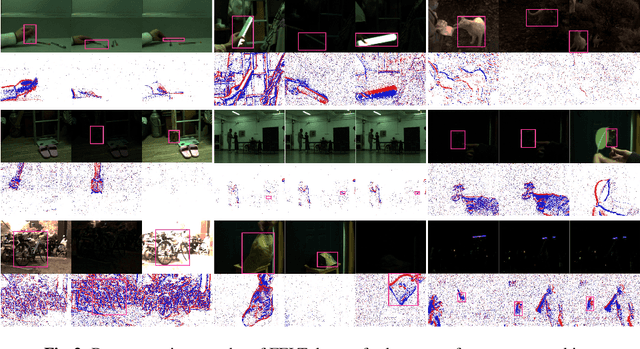
Abstract:Current event-/frame-event based trackers undergo evaluation on short-term tracking datasets, however, the tracking of real-world scenarios involves long-term tracking, and the performance of existing tracking algorithms in these scenarios remains unclear. In this paper, we first propose a new long-term and large-scale frame-event single object tracking dataset, termed FELT. It contains 742 videos and 1,594,474 RGB frames and event stream pairs and has become the largest frame-event tracking dataset to date. We re-train and evaluate 15 baseline trackers on our dataset for future works to compare. More importantly, we find that the RGB frames and event streams are naturally incomplete due to the influence of challenging factors and spatially sparse event flow. In response to this, we propose a novel associative memory Transformer network as a unified backbone by introducing modern Hopfield layers into multi-head self-attention blocks to fuse both RGB and event data. Extensive experiments on both FELT and RGB-T tracking dataset LasHeR fully validated the effectiveness of our model. The dataset and source code can be found at \url{https://github.com/Event-AHU/FELT_SOT_Benchmark}.
COURIER: Contrastive User Intention Reconstruction for Large-Scale Pre-Train of Image Features
Jun 08, 2023Abstract:With the development of the multi-media internet, visual characteristics have become an important factor affecting user interests. Thus, incorporating visual features is a promising direction for further performance improvements in click-through rate (CTR) prediction. However, we found that simply injecting the image embeddings trained with established pre-training methods only has marginal improvements. We attribute the failure to two reasons: First, The pre-training methods are designed for well-defined computer vision tasks concentrating on semantic features, and they cannot learn personalized interest in recommendations. Secondly, pre-trained image embeddings only containing semantic information have little information gain, considering we already have semantic features such as categories and item titles as inputs in the CTR prediction task. We argue that a pre-training method tailored for recommendation is necessary for further improvements. To this end, we propose a recommendation-aware image pre-training method that can learn visual features from user click histories. Specifically, we propose a user interest reconstruction module to mine visual features related to user interests from behavior histories. We further propose a contrastive training method to avoid collapsing of embedding vectors. We conduct extensive experiments to verify that our method can learn users' visual interests, and our method achieves $0.46\%$ improvement in offline AUC and $0.88\%$ improvement in Taobao online GMV with p-value$<0.01$.
Revisiting Color-Event based Tracking: A Unified Network, Dataset, and Metric
Nov 20, 2022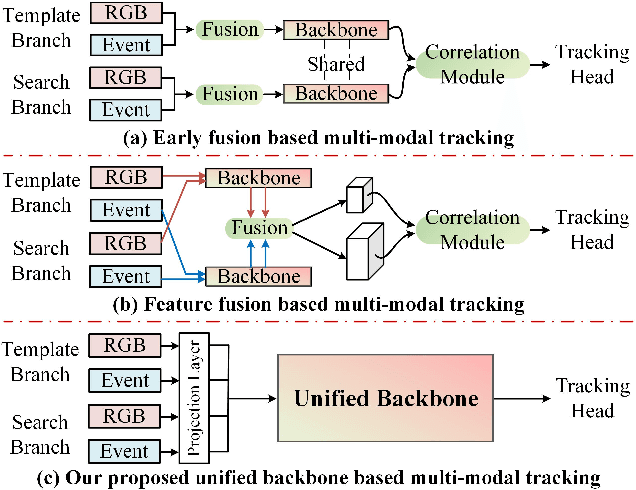

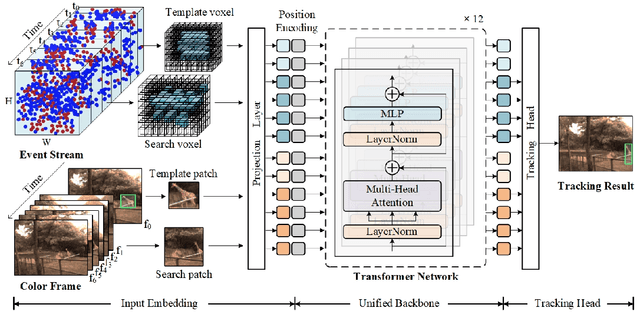

Abstract:Combining the Color and Event cameras (also called Dynamic Vision Sensors, DVS) for robust object tracking is a newly emerging research topic in recent years. Existing color-event tracking framework usually contains multiple scattered modules which may lead to low efficiency and high computational complexity, including feature extraction, fusion, matching, interactive learning, etc. In this paper, we propose a single-stage backbone network for Color-Event Unified Tracking (CEUTrack), which achieves the above functions simultaneously. Given the event points and RGB frames, we first transform the points into voxels and crop the template and search regions for both modalities, respectively. Then, these regions are projected into tokens and parallelly fed into the unified Transformer backbone network. The output features will be fed into a tracking head for target object localization. Our proposed CEUTrack is simple, effective, and efficient, which achieves over 75 FPS and new SOTA performance. To better validate the effectiveness of our model and address the data deficiency of this task, we also propose a generic and large-scale benchmark dataset for color-event tracking, termed COESOT, which contains 90 categories and 1354 video sequences. Additionally, a new evaluation metric named BOC is proposed in our evaluation toolkit to evaluate the prominence with respect to the baseline methods. We hope the newly proposed method, dataset, and evaluation metric provide a better platform for color-event-based tracking. The dataset, toolkit, and source code will be released on: \url{https://github.com/Event-AHU/COESOT}.
 Add to Chrome
Add to Chrome Add to Firefox
Add to Firefox Add to Edge
Add to Edge